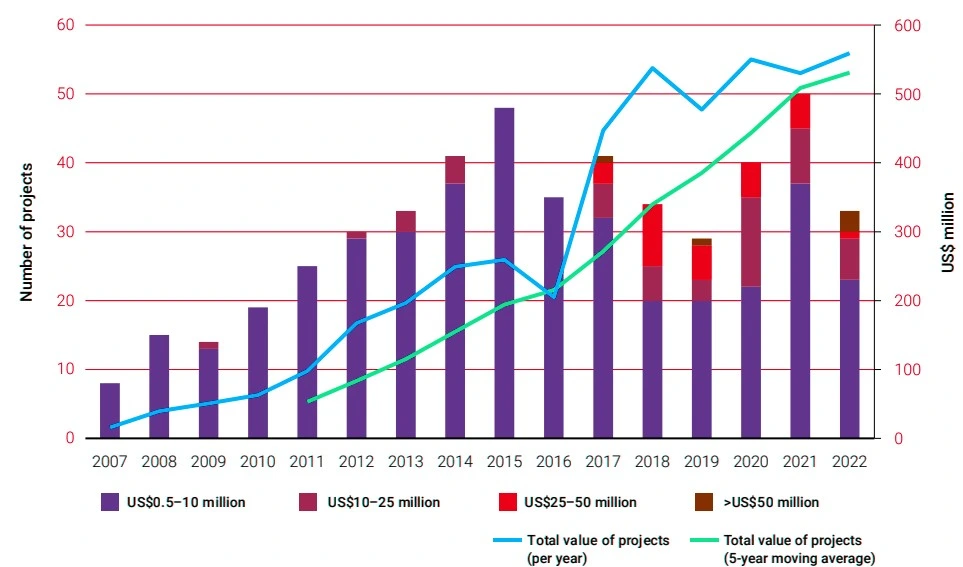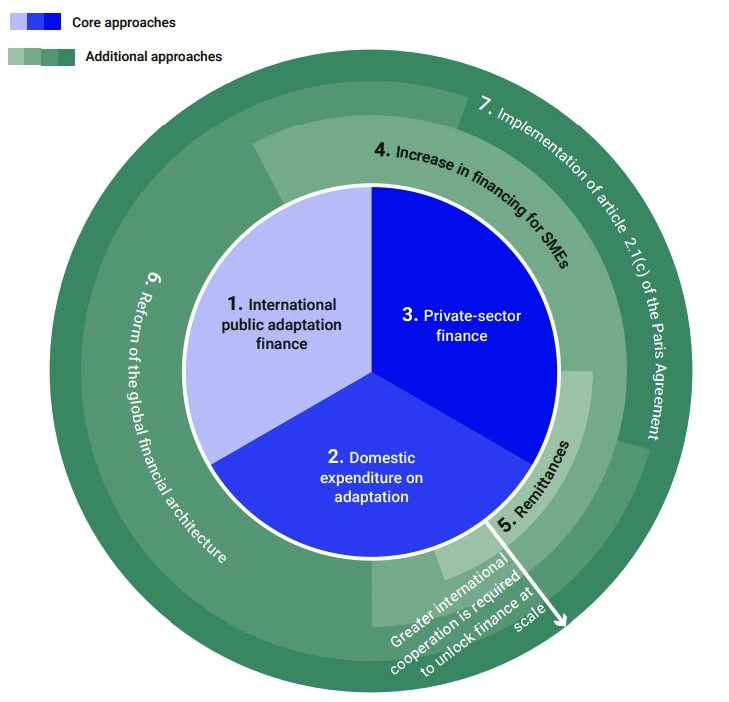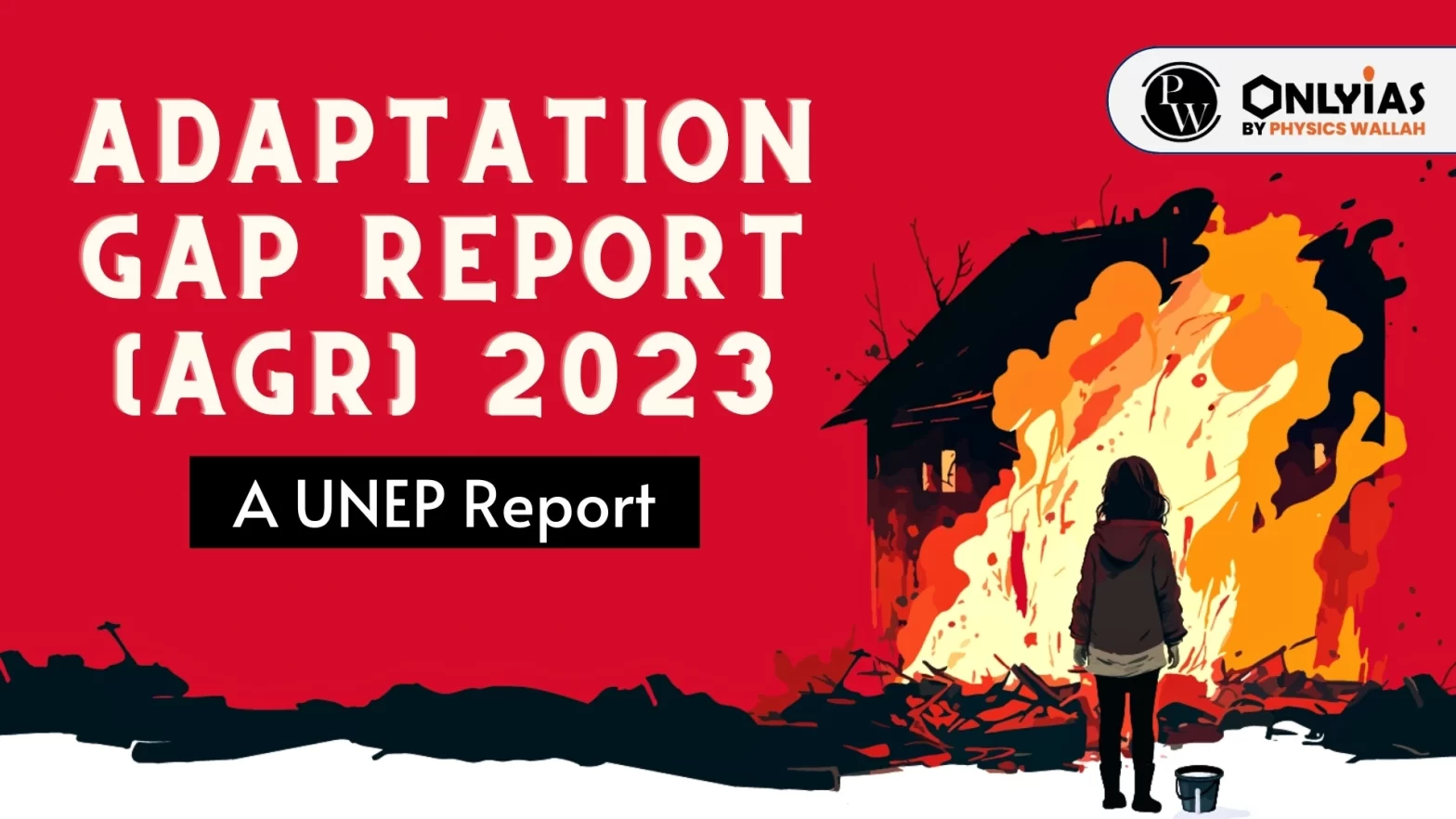Context:
- UNEP’s Adaptation Gap Report 2023: Underfinanced. Underprepared – Inadequate investment and planning on climate adaptation leaves the world exposed and finds that progress on climate adaptation is slowing on all fronts when it should be accelerating to catch up with rising climate change impacts.
United Nations Environment Programme (UNEP)
- Also known as UN Environment, it is headquartered in Nairobi, Kenya.
- It was established after the United Nations Conference on the Human Environment in Stockholm in June 1972.
- UNEP’s mission is to inspire, inform, and enable nations and peoples to improve their quality of life without compromising that of future generations.
|
Adaptation Gap Report 2023 – Key Findings of the Report
- Climate adaptation finance flows from public multilateral (like the World Bank) and bilateral sources (from a developed to a developing nation) declined by 15 percent to around $21 billion in 2021.
- This is despite pledges that were made at the 26th Conference of Parties to the United Nations Framework Convention on Climate Change in Glasgow to double 2019 adaptation finance support to around $40 billion per year by 2025.
- The adaptation finance gap is widening and now stands between US$194 billion and US$366 billion per year.
- Adaptation finance needs are 10–18 times as great as current international public adaptation finance flows – at least 50 percent higher than previously estimated.
- Estimated adaptation costs and needs for developing countries are significantly higher than previous estimates, with a plausible central range of US$215 billion to US$387 billion per year this decade.
- Five out of six Parties to the United Nations Framework Convention on Climate Change (UNFCCC) have established at least one national adaptation plan, strategy, or policy, and just under half of them have two or more national instruments, that serve to replace or update the initial ones.
- A recent study indicates that the 55 most climate-vulnerable economies alone have experienced losses and damages of more than US$500 billion in the last two decades.
- The AGR 2023 has analyzed the integration of gender equality and social inclusion in cost NDCs and NAPs. It finds that only 20 percent of these plans have a dedicated budget for such activities and that the amount allocated is generally low, averaging 2 percent.
About UNEP Adaptation Gap Report (AGR)
- The UNEP Adaptation Gap Report (AGR) series provides an annual science-based assessment of the global progress on adaptation planning, financing, and implementation.
- First published in 2014, the goal of the report is to inform policymakers and drive national and international adaptation efforts.
- It also explores options for ramping up these climate adaptation efforts.
- The AGR is co-produced by UNEP, the UNEP Copenhagen Climate Centre (UNEP-CCC), and the World Adaptation Science Programme (WASP).
- Other Major Report of UNEP: Emissions Gap Report, Global Environment Outlook
Relevant Terms
- Adaptation: The process of adjustment to actual or expected climate and its effects. In human systems, adaptation seeks to moderate or avoid harm or exploit beneficial opportunities. In some natural systems, human intervention may facilitate adjustment to the expected climate and its effects (IPCC 20221).
- Adaptation Costs: Costs of planning, preparing for, facilitating, and implementing adaptation measures, including transaction costs (IPCC 20072).
- Adaptation Gap: The difference between actually implemented adaptation and a societally set goal, determined largely by preferences related to tolerated climate change impacts and reflecting resource limitations and competing priorities (UNEP 20142).
|
Also Read: Interconnected Disaster Risks Report 2023 – UNU-EHS
What is the significance of Bridge Adaptation Finance and Measures?
Accelerating Global Temperature:
- Global temperatures and climate impacts and risks continue to rise, highlighting the urgent need for rapid acceleration of global adaptation action.
- While global average temperatures already exceed 1.1°C above pre-industrial levels, current plans reflected in the Nationally Determined Contributions (NDCs) are putting us towards 2.4°C–2.6°C by the end of the century.
Residual Climate Risk:
- The Intergovernmental Panel on Climate Change (IPCC) concludes that residual climate risks (that is risks remaining after ambitious adaptation efforts) will persist even if the Paris Agreement goals are reached. Residual climate risks, in turn, will inevitably lead to both economic and non-economic losses and damages.
Lack of a National Adaptation Planning Instrument:
- One out of six countries still does not have a national adaptation planning instrument and more must be done to close the remaining gap
Progress in adaptation implementation in developing countries is plateauing:
- The number of adaptation actions supported through the four international climate funds2 was lower in 2022 than in the previous year. Still, their value has been rising due to investments in very large projects (figure ES.3).

Gender equality and social inclusion:
- There is global recognition that climate change can exacerbate inequality in multiple dimensions of social identity, including gender, indigeneity, age, ethnicity, migrant status or disability.
- Of the international public finance for adaptation, only 2 percent is considered gender-responsive, with a further 24 percent considered gender-specific or integrative.
Minimize Climate Costs
- Studies indicate that every billion invested in adaptation against coastal flooding leads to a USD 14 billion reduction in economic damages.
- USD 16 billion per year invested in agriculture would prevent approximately 78 million people from starving or chronic hunger because of climate impacts.
Reducing Loss and Damage:
- Climate Vulnerable Economies Loss Report estimated that damages in the 55 most climate-vulnerable economies alone exceeded US$500 billion over the past two decades (figure ES.5).

| What are the adaptation strategies for climate change in India?
National Action Plan on Climate Change (NAPCC):
- It outlines a national strategy that aims to enable the country to adapt to climate change and enhance the ecological sustainability of India‘s development path.
- It stresses that maintaining a high growth rate is essential for increasing living standards of the vast majority of people of India and reducing their vulnerability to the impacts of climate change.
- There are Eight National Missions which form the core of the National Action Plan.
- National Solar Mission
- National Mission for Enhanced Energy Efficiency
- National Mission on Sustainable Habitat
- National Water Mission
- National Mission for Sustaining the Himalayan Eco-system
- National Mission for a Green India
- National Mission for Sustainable Agriculture
- National Mission on Strategic Knowledge for Climate Change
- They focus on promoting understanding of climate change, adaptation and mitigation, energy efficiency, and natural resource conservation.
National Adaptation Fund For Climate Change (India):
- It was established in August, 2015 to meet the cost of adaptation to climate change for the State and Union Territories of India that are particularly vulnerable to the adverse effects of climate change.
- NABARD has been designated as National Implementing Entity (NIE) for implementation of adaptation projects.
|
Way Forward: This Adaptation Gap Report 2023 identifies seven ways to bridge the adaptation financing gap (figure ES.5).
The core continues to be dominated by:
- International Public Adaptation Finance: LDCs rely most heavily on international support, particularly grants – and bridging the adaptation finance gap requires attention to both quantitative and qualitative aspects such as access to finance and equity.
- Domestic Expenditure on Adaptation: Increase and improve budget tagging and tracking. It can, therefore, help to spend government funds more consciously and to integrate climate risks more effectively.
- Private-sector Finance for Adaptation: Concessional finance can help encourage or de-risk private-sector investment and reduce the cost of capital, with the potential to also include technical assistance funds (grants) to help strengthen financial viability or provide support on key issues.
Four additional potential approaches to bridge the finance gap are identified:
- Remittances By Migrants: These are a potential supplementary source of finance for bridging the adaptation gap at the local level.
- Increasing Finance Tailored To Small And Medium-Sized Enterprises: SMEs hold considerable potential in unlocking climate adaptation solutions. Since SMEs constitute the bulk of the economy for many developing (and developed) countries, financing mechanisms should support their potential to offer adaptation-relevant products and services.
- Reform Of The Global Financial Architecture: The adaptation finance gap has become evident that this system is no longer fit to address today’s global challenges.
- This architecture, together with other financing institutions such as MDBs, holds a large and unused potential for helping developing countries to tackle 21st-century problems, including adaptation
- Implementing Article 2.1 (C) Of The Paris Agreement: Article 2.1(c) calls on governments to ‘make financial flows consistent with a pathway towards low greenhouse gas emissions and climate-resilient development’. This is a pre-condition for achieving the Agreement’s adaptation and mitigation goals, including limiting global warming to 1.5°C above pre-industrial levels
Also Read: Sustainable Development Summit (SDG)-2023
Conclusion:
Policymakers, multilateral banks, investors, and the private sector must make COP28 (2023) the moment that the world committed fully to insulating low-income countries and disadvantaged groups, such as women and Indigenous Peoples, from climate impacts.
| Prelims Question (2014)
Consider the following statements regarding ‘Earth Hour’
1. It is an initiative of UNEP and UNESCO
2. It is a movement in which the participants switch off the lights for one hour on a certain day every year.
3. It is a movement to raise the awareness about the climate change and the need to save the planet.
Which of the statements given above is/are correct ?
(a) 1 and 3 only
(b) 2 only
(c) 2 and 3 only
(d) 1, 2 and 3
Ans: (c) |



